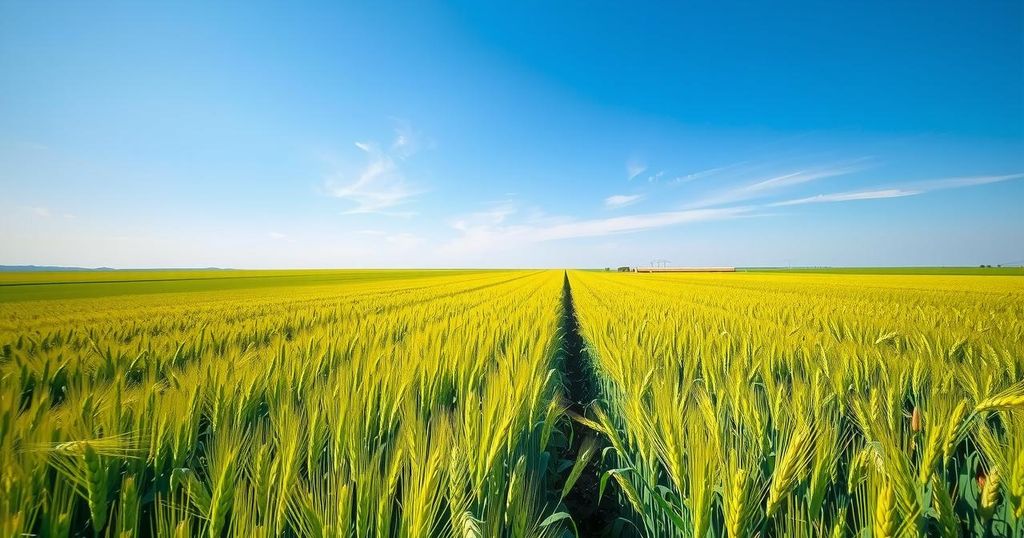Argentina’s Agricultural Boom: Weather-Driven Yields and Export Opportunities
- Favorable weather patterns are driving Argentina’s agricultural growth.
- Soybean harvest reached 52 million metric tons in 2024/25.
- Wheat planting is accelerating for the 2025/26 season.
- Argentina is positioned to fulfill Egypt’s rising wheat import needs.
- Investors may find opportunities in agribusiness stocks and farmland ETFs.
Argentina’s Agricultural Sectors Poised for Growth
The steady interplay of favorable climatic conditions, proactive policy interventions, and strong global demand is shaping a promising year for Argentina’s wheat and soybean sectors. After enduring years of instability, both farmers and investors are now presented with a landscape conducive to record-setting production and exponential export growth. As many are keen to observe, Argentina’s agricultural renaissance could offer substantial opportunities worth betting on.
Wheat Planting Makes Strides Amid Improving Conditions
As they enter the 2025/26 season, wheat planting in Argentina has noticeably picked up pace. The Buenos Aires Grains Exchange (BdeC) has reported that by late June, 72.7% of the expected 6.7 million hectares had been planted—which is a significant increase from just 60% weeks prior. Conditions have been ripe for planting due to a recent dry spell in June that alleviated earlier soil moisture concerns, and the Rosario Grains Exchange reports that the current soil moisture levels are now comparable to record-breaking 2021. Experts anticipate a wheat harvest of approximately 20.5 million metric tons (MT), marking a promising 15% rise over last year’s output, though rainfall forecasts for August and September will be critical for the health of the crops as they develop.
Soybean Harvest Exceeds Expectations Despite Challenges
Meanwhile, the conclusion of Argentina’s 2024/25 soybean harvest has produced surprisingly strong results despite initial drought worries. The USDA has confirmed that production for the season reached an impressive 52.0 million MT – that is a 7.9% improvement from a year ago, and a staggering 23% above the five-year average. The increase can be largely attributed to farmers transitioning areas from corn to soybeans, in response to challenges posed to corn by disease. Additionally, the recent reduction of export tax on soybeans—from 33% to 26%—has further enhanced Argentina’s competitiveness in the global market, especially with China showing robust demand for soy oil and soybean meal.
Strategic Investment Opportunities Emerge from Growth
Given these developments, Argentina finds itself well-positioned to meet international trading demands, particularly with Egypt increasing its wheat imports to 13 million MT for the next season. A fruitful Argentine wheat crop could reduce reliance on competing Black Sea suppliers, thus providing some stability in global pricing. The surplus in soybeans also bolsters the potential for increased exports of soybean meal and oil, which together comprise about 85% of the country’s agricultural exports. This momentum opens up numerous strategic investment opportunities within the agricultural sector; wheat futures are forecast to increase, agribusiness stocks such as Cargill and Bunge Limited could see profitability grow, and farmland ETFs like Invesco Agriculture provide avenues for investors wanting exposure to international agribusiness.
Navigating the Risks in Agricultural Investment.
However, it is essential for potential investors to remain aware of the risks involved. Weather volatility could potentially put pressure on wheat yields, particularly if August proves to be dry. Additionally, geopolitical dynamics surrounding Egypt’s procurement strategies and shifts in Black Sea supplies may lead to unpredictable price fluctuations. Moreover, uncertainties loom over policy changes as the favorable export tax reductions are set to conclude in June 2026, which could further complicate the investment landscape.
In summary, Argentina is experiencing a significant agricultural boom driven by proactive measures and favorable weather. With strong prospects for wheat production and an impressive soybean harvest, both local farmers and international investors should take notice. Despite some risks that remain, the context is set for a productive future, emphasizing potential avenues for investment in this blossoming sector.




Post Comment